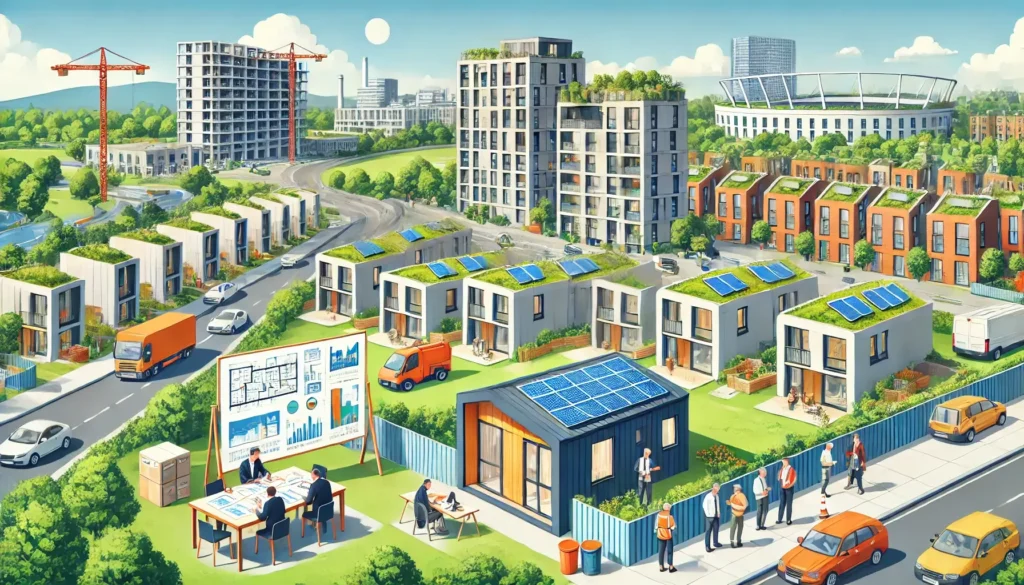Ireland’s housing crisis has reached critical levels, affecting families, individuals, and even the economy. Skyrocketing rents, a shortage of housing, and long public housing waiting lists have made it increasingly difficult for people to find a place to call home. While the problem is complex, solutions exist.
This article explores the root causes of the crisis and presents practical, innovative, and actionable steps to solve it.
1. Understanding the Problem
The housing crisis in Ireland can be summed up in four main issues:
- Not Enough Homes: There’s a housing shortfall of 250,000 homes. In 2023, only 30,000 homes were built, far below what’s needed.
- Skyrocketing Costs: Average rents in Dublin exceed €2,000/month, making housing unaffordable for many.
- Long Waiting Lists: Families often wait years for public housing.
- Homelessness: Over 12,000 people, including 3,000 children, are homeless.
| Problem | Details | Impact |
|---|---|---|
| Lack of Supply | Not enough houses being built | High competition, rising prices |
| High Costs | Expensive rents and property prices | Affordability issues for families |
| Long Waiting Lists | Delays in public housing availability | Stress for low-income individuals |
| Homelessness | Rising number of people without homes | Social and economic consequences |
2. Increasing Housing Supply
The most effective way to fix the crisis is to build more homes. Here’s how:
Speed Up Construction
- Streamline Planning: Cut through red tape and speed up housing approvals.
- Modular and Prefabricated Homes: These methods reduce costs by 30-50% and cut construction time by half.
| Building Method | Cost Per Unit (€) | Construction Time | Sustainability |
|---|---|---|---|
| Traditional Construction | 150,000-200,000 | 12-24 months | Moderate |
| Modular Homes | 100,000-150,000 | 6-12 months | High |
| 3D Printing | 50,000-100,000 | 3-6 months | High |
Utilize Vacant Properties
- Over 166,000 vacant properties exist in Ireland.
- Introduce a vacant property tax to encourage owners to sell or rent these homes.
- Offer financial incentives for landlords to renovate and lease unused properties.
Increase Public Housing
- The government should expand funding to build 50,000 affordable units annually.
- Partner with non-profits and private developers to speed up construction.
3. Controlling Rising Costs
Affordability is a key issue. Here are ways to bring down housing costs:
Introduce Rent Caps
- Limit Rent Increases: Landlords should only be allowed to raise rents by a small percentage each year.
- Example: Berlin, Germany, stabilized rents by capping increases, though it paired this with increased housing supply.
Tax Breaks for Builders
- Reduce VAT on construction materials.
- Provide tax relief for developers building affordable housing.
Prevent Land Hoarding
- Penalize companies or individuals who sit on undeveloped land, delaying housing projects.
4. Improving Government Policies
Better policies can address the housing crisis more effectively.
Affordable Housing Schemes
- Expand programs like Help-to-Buy, which supports first-time buyers.
- Offer low-interest government loans to help families purchase homes.
Enforce Planning Deadlines
- Set strict timelines for local councils to approve or reject planning applications.
- Prioritize residential projects over commercial developments.
Public-Private Partnerships
- Encourage collaboration between the government and private developers to build affordable housing faster.
| Policy | Estimated Cost (€) | Expected Impact | Timeframe |
|---|---|---|---|
| Building Public Housing | 3 billion/year | 50,000 affordable units annually | Long-term |
| Rent Caps | Minimal | Stabilized rents for 1 million renters | Immediate |
| Vacant Property Tax | Low | 10,000+ properties back into use annually | Short-term |
5. Supporting Renters and Buyers
Housing assistance is essential for those most affected by the crisis.
Support for Renters
- Housing Allowances: Provide financial support to low-income renters.
- Strengthen Legal Protections: Prevent unfair evictions and ensure tenants have secure leases.
Help for Buyers
- Shared Ownership Schemes: Buyers co-own their property with the government or developers, reducing upfront costs.
- Rent-to-Buy Programs: Allow renters to gradually purchase their homes by applying part of their rent to the purchase price.
6. Exploring Innovative Solutions
Ireland’s housing crisis requires fresh, creative ideas.
Micro-Homes and Co-Living Spaces
- Build compact, affordable housing for singles and couples.
- Develop shared living spaces with private bedrooms but communal kitchens and amenities.
Community Land Trusts (CLTs)
- Communities purchase land collectively to ensure long-term affordability.
- Example: CLTs in the UK provide homes at 40% below market rates.
Green Housing Projects
- Incorporate solar panels, energy-efficient designs, and sustainable materials to lower utility costs.
- Example: Scandinavian housing developments have cut energy bills by 50%.
Technology in Construction
- Use 3D printing to build homes in weeks rather than months, significantly reducing labor costs.
7. Real-Life Stories
A Family’s Struggle
John and Sarah, a couple with two kids, were evicted from their rental home due to rising rents. They now live in temporary accommodations, paying over €1,000/month for a single room.
Student Housing Crisis
Emma, a university student, commutes two hours daily because affordable housing near her college is unavailable.
These stories remind us that the housing crisis affects real people, and urgent action is needed.
FAQs About Solving the Housing Crisis in Ireland
1. Why is there a housing crisis in Ireland?
The housing crisis in Ireland stems from a combination of factors:
- A shortage of new homes being built to meet demand.
- Skyrocketing property prices and rents, particularly in urban areas.
- Inefficient planning systems that slow down construction.
- A large number of vacant properties and underutilized land.
2. What can the government do to fix the housing crisis?
The government can implement several strategies, including:
- Building more public housing to provide affordable options for low-income families.
- Introducing rent caps to stabilize rental prices.
- Streamlining the planning process to speed up housing projects.
- Penalizing land hoarding and incentivizing the use of vacant properties.
3. How can modular homes help address the crisis?
Modular homes are faster and cheaper to build compared to traditional construction methods. They can reduce costs by 30-50% and construction time by half, making them an efficient solution to quickly increase housing supply.
4. Are there examples of successful housing policies from other countries?
Yes, several countries have implemented effective housing policies:
- Vienna, Austria: Over 60% of residents live in subsidized housing, ensuring affordability.
- The Netherlands: Uses co-housing and modular construction to meet housing needs.
- Berlin, Germany: Rent caps have helped stabilize rental prices.
5. How can individuals contribute to solving the housing crisis?
Individuals can take several actions:
- Advocate for better housing policies by contacting local representatives.
- Support charities like Focus Ireland or Simon Communities that help homeless individuals.
- Raise awareness about the crisis and possible solutions through social media and community discussions.
8. Conclusion
Ireland’s housing crisis won’t be solved overnight, but with clear policies, innovative solutions, and collaboration between the government, private sector, and communities, progress is achievable.
What Can You Do?
- Advocate for change by contacting local representatives.
- Support housing charities like Focus Ireland and Simon Communities.
- Share this information to raise awareness.
Together, we can make Ireland a place where everyone has a safe and affordable home.

Hi, I’m Tanvir, the founder and author of Explore Ireland Now. With a deep love for Ireland and its rich culture, history, and landscapes, I created this site to share everything that makes this beautiful country worth exploring. Whether you’re a local looking for hidden gems or a traveler planning your next adventure, I provide insightful guides, tips, and recommendations to help you experience Ireland to the fullest.
From stunning landscapes to vibrant cities and quaint villages, Ireland is full of wonders waiting to be discovered. Through my personal experiences and research, I aim to bring you the most up-to-date information and inspiration for your journey.
Thank you for visiting Explore Ireland Now—I hope my content helps you uncover all that this incredible country has to offer! If you have any questions or need travel advice, feel free to reach out.



